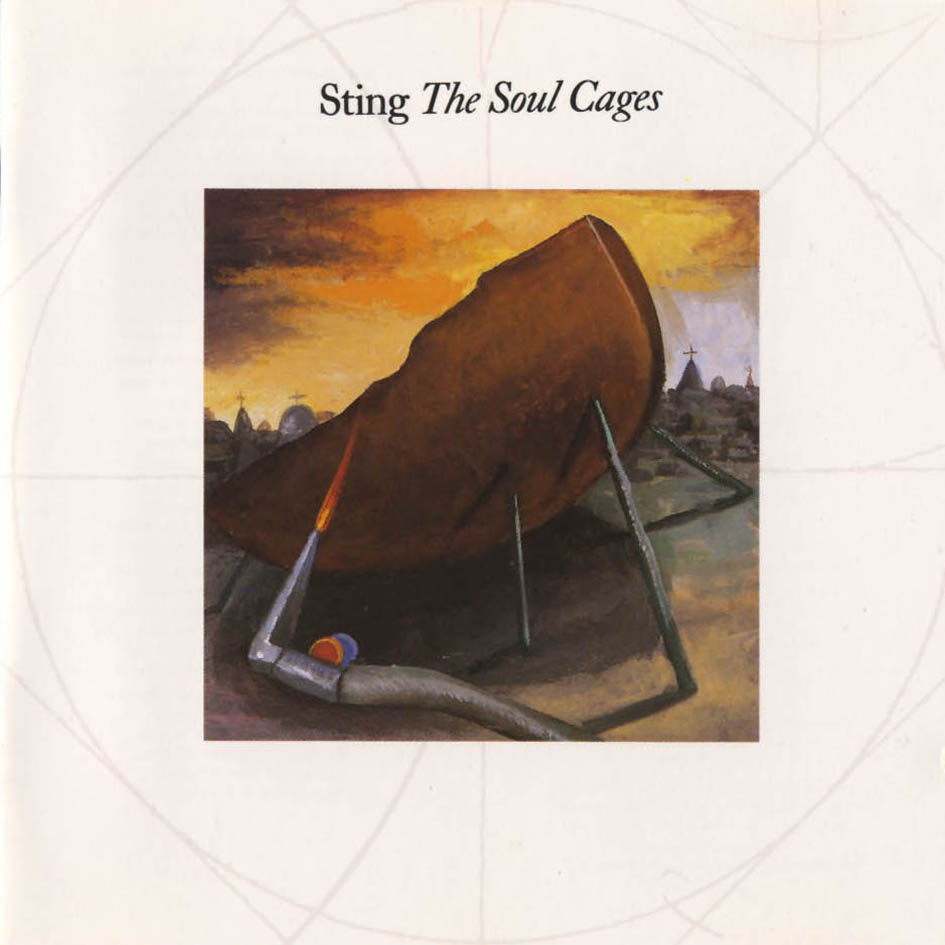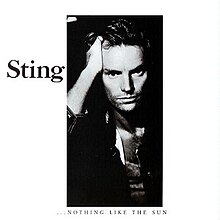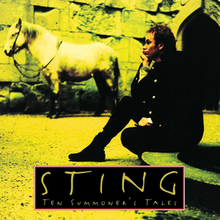
Rock and roll music

1991 studio album by Sting
| Review scores | |
|---|---|
| Source | Rating |
| AllMusic | [5] |
| Chicago Tribune | [6] |
| Robert Christgau | [7] |
| Entertainment Weekly | C[8] |
| Los Angeles Times | [9] |
| NME | 4/10[10] |
| Orlando Sentinel | [11] |
| The Windsor Star | B[12] |
The Soul Cages is the third full-length studio album by English musician Sting. Released on 17 January 1991[13] it became Sting`s second No. 1 album in the United Kingdom.[14]
Leer másSoul Cages
Sting
Label: A&M PolyGram(Hong Kong) · Studios: Studio Guillaume Tell (Paris, France); Villa Salviati (Migliarino, Italy). · Productor: Hugh Padgham
|
1
|
Island Of Souls
Sting •
Sting •
w: Sting •
1991 /01 /17
|
6:37 |
|
|
|
2
|
All This Time
Sting •
Sting •
w: Sting •
1991 /01 /17
|
4:51 |
|
|
|
3
|
Mad About You
Sting •
Sting •
w: Sting •
1991 /01 /17
|
3:53 |
|
|
|
4
|
Jeremiah Blues (part 1)
Sting •
Sting •
w: Sting •
1991 /01 /17
|
4:51 |
|
|
|
5
|
Why Should I Cry For You
Sting •
Sting •
w: Sting •
1991 /01 /17
|
4:43 |
|
|
|
6
|
Saint Agnes And The Burning Train
Sting •
Sting •
w: Sting •
1991 /01 /17
|
2:41 |
|
|
|
7
|
The Wild Wild Sea
Sting •
Sting •
w: Sting •
1991 /01 /17
|
6:37 |
|
|
|
8
|
The Soul Cages
Sting •
Sting •
w: Sting •
1991 /01 /17
|
5:48 |
|
|
|
9
|
When The Angels Fall
Sting •
Sting •
w: Sting •
1991 /01 /17
|
7:44 |
|
Singles
No singles available
| The Soul Cages | ||||
|---|---|---|---|---|
 | ||||
| Studio album by | ||||
| Released | 17 January 1991 | |||
| Recorded | April – November 1990 | |||
| Studio | Studio Guillaume Tell (Paris, France); Villa Salviati (Migliarino, Italy). | |||
| Genre | Pop rock[1] | |||
| Length | 48:11 | |||
| Label | ||||
| Producer | Hugh Padgham | |||
| Sting chronology | ||||
| ||||
| Singles from The Soul Cages | ||||
| ||||
Review
1991 studio album by Sting
| Review scores | |
|---|---|
| Source | Rating |
| AllMusic | [5] |
| Chicago Tribune | [6] |
| Robert Christgau | [7] |
| Entertainment Weekly | C[8] |
| Los Angeles Times | [9] |
| NME | 4/10[10] |
| Orlando Sentinel | [11] |
| The Windsor Star | B[12] |
The Soul Cages is the third full-length studio album by English musician Sting. Released on 17 January 1991[13] it became Sting`s second No. 1 album in the United Kingdom.[14]
Leer másIt spawned four singles: "All This Time", "Mad About You", "The Soul Cages", and "Why Should I Cry for You?". Both "All This Time" and "Why Should I Cry for You?" were included on Sting`s 1994 compilation album Fields of Gold: The Best of Sting 1984–1994; "Mad About You" was also included on the international version of the compilation. The title track won the first Grammy Award for Best Rock Song in 1992.[15]
On 15 January 2021, an expanded version of The Soul Cages was released to celebrate its 30th anniversary. Along with the original nine tracks, this new edition includes 13 bonus tracks that consist of remixes, extended mixes, and a pair of songs sung in Spanish and Italian incarnations.[16]
Concept
The Soul Cages is a concept album focused on the death of Sting`s father.[17] Sting had developed a writer`s block shortly after his father`s death in 1987; the episode lasted several years, until he was able to overcome his affliction by dealing with the death of his father through music.[18] The single, "Why Should I Cry for You", was written for The Soul Cages in 1989, and Sting has said that the rest of the album flowed quite easily after that first hurdle was overcome. Most of the songs have motifs related to sailing or the seas; Sting wrote in his autobiography, Broken Music, that his father had always regretted not becoming a sailor. There are also references to Newcastle, the part of England where Sting grew up.[17]
"I lived next to a shipyard when I was young and it was a very powerful image of this huge ship towering above the house. Tapping into that was a godsend – I began with that and the album just flowed." – Sting[18]
In an interview with Charlie Rose aired on 10 December 2010, Sting mentioned that he was working on a "mood piece", a musical project and book in collaboration with Pulitzer winner Brian Yorkey. The work would be based on an album he released many years ago concerning the loss of his father, growing up in Newcastle and witnessing the passing of the shipbuilding industry there. He admitted being scared of the prospect of pulling it all together but expressed confidence in it working out. This project has since been confirmed as the musical The Last Ship.[19]
Packaging
At the time this album appeared, the music industry was starting to shift away from using CD longboxes. Sting, a committed environmentalist, wanted to eliminate the amount of cardboard waste caused by the longbox. The original packaging was a fourfold cardboard case that could be modified to look like a longbox, and folded back into a jewel box sized CD package for home storage. In Germany, the CD was sold in jewel cases as well as longboxes. The cover painting was a commissioned work by the Scottish artist Steven Campbell.
Until the release of Symphonicities in July 2010, The Soul Cages was the only studio album by Sting not to feature a photograph of himself on the front cover, although he does appear on the back cover of both albums.
Track listing
Side one
- "Island of Souls" – 6:41
- "All This Time" – 4:54
- "Mad About You" – 3:53
- "Jeremiah Blues (Part 1)" – 4:54
- "Why Should I Cry for You" – 4:46
Side two
- "Saint Agnes and the Burning Train" – 2:43
- "The Wild Wild Sea" – 6:41
- "The Soul Cages" – 5:51
- "When the Angels Fall" – 7:48
Personnel
Musicians
- Sting – vocals, Synclavier, mandolin, bass, arrangements
- Kenny Kirkland – keyboards
- David Sancious – keyboards
- Dominic Miller – guitars
- Manu Katché – drums
- Skip Burney – percussion
- Ray Cooper – percussion
- Munyungo Jackson – percussion
- Vinx De`Jon Parrette – percussion
- Bill Summers – percussion
- Tony Vacca – percussion
- Branford Marsalis – saxophones
- Paola Paparelle – oboe
- Kathryn Tickell – Northumbrian smallpipes
Production
- Produced by Sting and Hugh Padgham; QSound production assisted by Brian Cowieson and Scott Willing
- Recorded and mixed by Hugh Padgham; Assisted by Simon Osbourne, Yves Jaget, Bruce Keene, Al Stone, Brian Scheuble and Efren Herrera
- Technical assistant to Sting – Danny Quatrochi
- Mastered by Bob Ludwig
- Mixed at The Town House (London, England) and A&M Studios (Hollywood, California)
- Mastered at Masterdisk (New York City, New York)
- Design – Richard Frankel and Len Peltier
- Front cover painting and inside illustrations by Steven Campbell
- Photographs of Sting by Guzman
- All songs published by Magnetic Publishing, Ltd/Blue Turtle Music
Singles
- "All This Time" (1991) – No. 5 US Hot 100, No. 1 US Mainstream Rock, No. 1 US Modern Rock, No. 9 US Adult Contemporary, No. 22 UK Singles Chart
- "Mad About You" (1991) – No. 56 UK Singles Chart[14]
- "Why Should I Cry For You" (1991) – No. 32 US Mainstream Rock, No. 40 US Rock Digital Singles
- "The Soul Cages" (1991) – No. 7 US Mainstream Rock, No. 9 US Modern Rock, No. 57 UK Singles Chart
Charts
Weekly charts
| Year-end charts
|
Certifications and sales
| Region | Certification | Certified units/sales |
|---|---|---|
| Australia (ARIA)[43] | Gold | 35,000^ |
| Austria (IFPI Austria)[44] | Gold | 25,000* |
| Belgium (BEA)[45] | Gold | 40,000[45] |
| Canada (Music Canada)[46] | Platinum | 100,000^ |
| Finland (Musiikkituottajat)[47] | Gold | 26,040[47] |
| France (SNEP)[48] | Platinum | 300,000* |
| Germany (BVMI)[49] | Platinum | 500,000^ |
| Italy | — | 500,000[50] |
| Japan (RIAJ)[52] | Gold | 185,820[51] |
| Spain (PROMUSICAE)[53] | Platinum | 100,000^ |
| Switzerland (IFPI Switzerland)[54] | Platinum | 50,000^ |
| United Kingdom (BPI)[55] | Gold | 100,000^ |
| United States (RIAA)[56] | Platinum | 1,000,000^ |
* Sales figures based on certification alone. | ||
1991 studio album by Sting
| Review scores | |
|---|---|
| Source | Rating |
| AllMusic | [5] |
| Chicago Tribune | [6] |
| Robert Christgau | [7] |
| Entertainment Weekly | C[8] |
| Los Angeles Times | [9] |
| NME | 4/10[10] |
| Orlando Sentinel | [11] |
| The Windsor Star | B[12] |
The Soul Cages is the third full-length studio album by English musician Sting. Released on 17 January 1991[13] it became Sting`s second No. 1 album in the United Kingdom.[14]
It spawned four singles: "All This Time", "Mad About You", "The Soul Cages", and "Why Should I Cry for You?". Both "All This Time" and "Why Should I Cry for You?" were included on Sting`s 1994 compilation album Fields of Gold: The Best of Sting 1984–1994; "Mad About You" was also included on the international version of the compilation. The title track won the first Grammy Award for Best Rock Song in 1992.[15]
On 15 January 2021, an expanded version of The Soul Cages was released to celebrate its 30th anniversary. Along with the original nine tracks, this new edition includes 13 bonus tracks that consist of remixes, extended mixes, and a pair of songs sung in Spanish and Italian incarnations.[16]
Concept
The Soul Cages is a concept album focused on the death of Sting`s father.[17] Sting had developed a writer`s block shortly after his father`s death in 1987; the episode lasted several years, until he was able to overcome his affliction by dealing with the death of his father through music.[18] The single, "Why Should I Cry for You", was written for The Soul Cages in 1989, and Sting has said that the rest of the album flowed quite easily after that first hurdle was overcome. Most of the songs have motifs related to sailing or the seas; Sting wrote in his autobiography, Broken Music, that his father had always regretted not becoming a sailor. There are also references to Newcastle, the part of England where Sting grew up.[17]
"I lived next to a shipyard when I was young and it was a very powerful image of this huge ship towering above the house. Tapping into that was a godsend – I began with that and the album just flowed." – Sting[18]
In an interview with Charlie Rose aired on 10 December 2010, Sting mentioned that he was working on a "mood piece", a musical project and book in collaboration with Pulitzer winner Brian Yorkey. The work would be based on an album he released many years ago concerning the loss of his father, growing up in Newcastle and witnessing the passing of the shipbuilding industry there. He admitted being scared of the prospect of pulling it all together but expressed confidence in it working out. This project has since been confirmed as the musical The Last Ship.[19]
Packaging
At the time this album appeared, the music industry was starting to shift away from using CD longboxes. Sting, a committed environmentalist, wanted to eliminate the amount of cardboard waste caused by the longbox. The original packaging was a fourfold cardboard case that could be modified to look like a longbox, and folded back into a jewel box sized CD package for home storage. In Germany, the CD was sold in jewel cases as well as longboxes. The cover painting was a commissioned work by the Scottish artist Steven Campbell.
Until the release of Symphonicities in July 2010, The Soul Cages was the only studio album by Sting not to feature a photograph of himself on the front cover, although he does appear on the back cover of both albums.
Track listing
Side one
- "Island of Souls" – 6:41
- "All This Time" – 4:54
- "Mad About You" – 3:53
- "Jeremiah Blues (Part 1)" – 4:54
- "Why Should I Cry for You" – 4:46
Side two
- "Saint Agnes and the Burning Train" – 2:43
- "The Wild Wild Sea" – 6:41
- "The Soul Cages" – 5:51
- "When the Angels Fall" – 7:48
Personnel
Musicians
- Sting – vocals, Synclavier, mandolin, bass, arrangements
- Kenny Kirkland – keyboards
- David Sancious – keyboards
- Dominic Miller – guitars
- Manu Katché – drums
- Skip Burney – percussion
- Ray Cooper – percussion
- Munyungo Jackson – percussion
- Vinx De`Jon Parrette – percussion
- Bill Summers – percussion
- Tony Vacca – percussion
- Branford Marsalis – saxophones
- Paola Paparelle – oboe
- Kathryn Tickell – Northumbrian smallpipes
Production
- Produced by Sting and Hugh Padgham; QSound production assisted by Brian Cowieson and Scott Willing
- Recorded and mixed by Hugh Padgham; Assisted by Simon Osbourne, Yves Jaget, Bruce Keene, Al Stone, Brian Scheuble and Efren Herrera
- Technical assistant to Sting – Danny Quatrochi
- Mastered by Bob Ludwig
- Mixed at The Town House (London, England) and A&M Studios (Hollywood, California)
- Mastered at Masterdisk (New York City, New York)
- Design – Richard Frankel and Len Peltier
- Front cover painting and inside illustrations by Steven Campbell
- Photographs of Sting by Guzman
- All songs published by Magnetic Publishing, Ltd/Blue Turtle Music
Singles
- "All This Time" (1991) – No. 5 US Hot 100, No. 1 US Mainstream Rock, No. 1 US Modern Rock, No. 9 US Adult Contemporary, No. 22 UK Singles Chart
- "Mad About You" (1991) – No. 56 UK Singles Chart[14]
- "Why Should I Cry For You" (1991) – No. 32 US Mainstream Rock, No. 40 US Rock Digital Singles
- "The Soul Cages" (1991) – No. 7 US Mainstream Rock, No. 9 US Modern Rock, No. 57 UK Singles Chart
Charts
Weekly charts
| Year-end charts
|
Certifications and sales
| Region | Certification | Certified units/sales |
|---|---|---|
| Australia (ARIA)[43] | Gold | 35,000^ |
| Austria (IFPI Austria)[44] | Gold | 25,000* |
| Belgium (BEA)[45] | Gold | 40,000[45] |
| Canada (Music Canada)[46] | Platinum | 100,000^ |
| Finland (Musiikkituottajat)[47] | Gold | 26,040[47] |
| France (SNEP)[48] | Platinum | 300,000* |
| Germany (BVMI)[49] | Platinum | 500,000^ |
| Italy | — | 500,000[50] |
| Japan (RIAJ)[52] | Gold | 185,820[51] |
| Spain (PROMUSICAE)[53] | Platinum | 100,000^ |
| Switzerland (IFPI Switzerland)[54] | Platinum | 50,000^ |
| United Kingdom (BPI)[55] | Gold | 100,000^ |
| United States (RIAA)[56] | Platinum | 1,000,000^ |
* Sales figures based on certification alone. | ||
More Albums same artist
VIDEOS
See Video Album Soul CagesIsland Of Souls · Channel: Sting - Topic · 6m 42s


Sting - All This Time · Channel: StingVEVO · 4m 54s

Sting - Mad About You (Official Music Video) · Channel: StingVEVO · 3m 54s

Jeremiah Blues (Part 1) · Channel: Sting - Topic · 4m 55s

Sting - Why Should I Cry For You? (Official Music Video) · Channel: StingVEVO · 4m 29s

Saint Agnes And The Burning Train · Channel: Sting - Topic · 2m 44s

The Wild Wild Sea · Channel: Sting - Topic · 6m 40s

Sting - The Soul Cages (Official Music Video) · Channel: StingVEVO · 5m 40s






